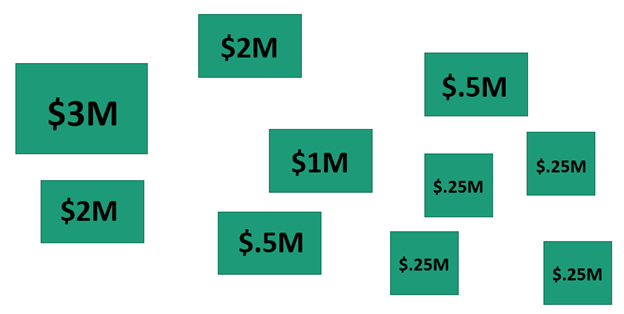What Is Category Weighted Distribution (CWD)?
In Circana data, distribution percentage is calculated as "Category Weighted Distribution". How does this differ from a standard distribution percentage? What are the benefits of calculating distribution percentage this way?
Category Weighted Distribution, which is named "CWD (Max)" on the dashboards, is a percentage measure which assigns weight to each store based solely upon sales of a single category: the beer category, spirits category, or wine category. For example, Circana's “beer category” includes multiple segments: Craft, Domestic Premium, Ciders, FMBs, Imports, etc.
Revenue from the entire category is taken into account and summed when Circana assigns category weight to each store within a geography. The calculation is not affected by what is (or isn't) selected in the CATEGORY filter on the dashboards (or, the "SEGMENT" filter in the Beer CMA).
The question posed by Category Weighted Distribution is: Looking at a single geography, how available is your product to the customers who are purchasing the most category items in that geography?
Here's a visual look at how this works.
Here, we’re looking at a single geography. In this example, the geography is comprised of ten stores which generated a total of 10 million category dollars within the timeframe you have selected in your CMA.
Note that Category Weighted Distribution is not simply looking at the number of physical locations a product is being sold in - it’s also looking at where the dollars are being spent. This group of stores generates 10 million in category dollars, but not evenly:

And, if the item/SKU which you’re analyzing is scanned in two of these ten stores during a given week, but those two stores collectively generated a total of 5 million category dollars (out of the market’s total 10 million), that item's Category Weighted Distribution is 50%.

So, continuing with this example, what does 50% CWD mean, exactly? It means that your product is available in stores which generate 50% of the geography's total category dollars. In other words, even though it’s only selling in these two stores, the item has reached 50% availability to the category's customers in that market, because it's sold in two stores which collectively generated 5 million out of the total 10 million.
To drive the point home, if an item/SKU is selling in three of these ten stores, and those three stores collectively generate a total of 1 million dollars (out of the market’s total 10 million), the item has a Category Weighted Distribution of 10%.

CWD is calculated separately by Circana at the item/SKU level, the Brand level, and the Brand Family level. For more about how that works, see this article.
CWD is about making sure that you're “fishing where the fish are”. In any given geography, what is a product’s availability to those consumers who are generating the bulk of revenue for a particular category? As evident in the diagrams above, the driving forces of CWD are less about the number of stores a product is in and more about which stores the product is in. If a product is performing well, is the buyer giving it the level of availability to beer category customers that it should have, in order to maximize their profits?
Please also note that CWD is labeled as "CWD (Max)" in the CMA dashboards. This is because the CWD calculation is always giving us the highest weekly CWD percentage in the selected timeframe. In Circana data, a new CWD percentage is calculated for each week (for each SKU, Brand, and Brand Family). But, when looking across multiple weeks, we're always given the CWD for whichever single week had the highest CWD percentage across that timeframe.
CWD is often leveraged with buyers in combination with Circana's velocity measure (Dollar Sales per Point of CWD). To learn about Dollar Sales per Point of CWD, jump to this article.
And, for a more in depth look at leveraging the combination of CWD and Dollar Sales per Point of CWD with a buyer, jump to this article.
